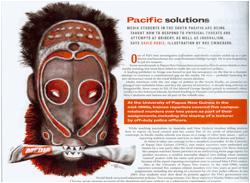
 Independent journalism in the South Pacific: Two campus-based media case studies in Fiji and New Zealand
Independent journalism in the South Pacific: Two campus-based media case studies in Fiji and New Zealand
Abstract
Abstract: Two South Pacific regional journalism university publications, one digital and the other primarily print-based, have developed innovative and convergent partnerships with the news media industry and have become strategic models. Founded in 1996, Wansolwara, the newspaper of the University of the South Pacific regional journalism programme, has embarked on a publishing partnership with a leading Fiji daily newspaper, the Fiji Sun. Auckland University of Technology’s Pacific Media Centre, established more than a decade later, and its news offshoot with an Asia-Pacific focus, Pacific Scoop, is working in tandem with New Zealand’s leading independent online media organisation, Scoop Media Limited. Both publishing ventures represent parallel media strategies to combat growing regional censorship represented by Fiji’s Media Industry Development Decree 2010. This paper examines case studies of both publications in Fiji and New Zealand. It assesses their publishing profiles and contrasts their independent brands focused on education, environmental issues – particularly climate change and deforestation – human rights, resource development, social justice, culture and language with mainstream media within a context of problem-based learning (PBL)and geopolitical strategies.
Introduction
Independent media coverage of the South Pacific has faced mounting pressures over the past decade, especially since the fourth coup d’état in Fiji in 2006 when the military backed regime imposed a harsh censorship mediascape through an unpopular Decree. The problems are equally faced by news media being developed by journalism schools with regional programmes. Two Pacific regional journalism university publications, in particular, one digital and the other primarily print-based, have been developing innovative and convergent partnerships with the news media industry. Some see them as strategic models. Founded in 1996, Wansolwara, the newspaper of the University of the South Pacific regional journalism programme, embarked on a publishing partnership with a leading Fiji daily newspaper, the Fiji Sun, almost three years ago. The Auckland University of Technology’s Pacific Media Centre, established more than a decade after USP’s newspaper, with an online news portal and its media offshoot with an Asia-Pacific focus, Pacific Scoop, is working in tandem with New Zealand's leading independent online media group, Scoop Media Limited. Both publishing ventures represent parallel media strategies to combat growing regional censorship represented by Fiji’s Media Industry Development Decree 2010. This paper examines case studies of both publications in Fiji and New Zealand. It assesses their publishing profiles and contrasts their independent brands focused on education, environmental issues – particularly climate change and deforestation – human rights, resource development, social justice, culture and language with mainstream media within a context of problem-based learning (PBL) and geopolitical strategies.
The Decree ended a four-decade tradition of self-regulation of the media in Fiji since independence from Britain in 1970. This law followed 15 months of censorship of the nation’s media imposed by the Public Emergency Regulation (PER) in April 2009 (eventually lifted on 1 January 2012). The Decree requires any printed article of a length greater than 50 words to include a “byline” to identify the author. The new law also mandates jail terms for journalists whose work is deemed against the “public interest or order”, which is ill-defined. Breaches of the decree are punishable by a fine of up to $10,000 or imprisonment of up to two years, and the penalty for any company which commits an offence may be as high as $100,000. A highly controversial clause of the Decree restricted foreign ownership of the media to not more than 10 percent and a three-month deadline to comply. This latter clause eventually forced the sale of the regime’s most vocal media critic, The Fiji Times, founded in 1869 and previously owned by Rupert Murdoch’s News Limited, to the locally owned Motibhai Group (Bhim, 2010; Dutt, 2010; Fiji promulgates media law; 2010; Singh, 2010).
Overnight, news critical of the government dried up. Government opponents in the trade unions, academic and politics were effectively silenced, although a few received some foreign media coverage. It was a new, uncanny experience for Fiji which, apart from a brief period after the coups of 1987, has always had a free media on a par with Australia and New Zealand (Singh, 2010: 148).
Both campus-based publishing ventures at AUT University and the University of the South Pacific have strongly identified with a national development role and produced many editors and senior journalists in the contemporary Pacific press, particularly from USP. Wansolwara established a news website, Pacific Journalism Online, which distinguished itself with coverage of the George Speight attempted coup in Fiji in 2000. In November 2003, Auckland University of Technology began publishing Te Waha Nui as a regular professional course publication—the first newspaper of its kind produced by a New Zealand journalism school. Four years later, Pacific Media Centre Online was established as a uniquely digital publication and resource. The partnership publication with Scoop Media, Pacific Scoop, was launched in 2009.
Using a problem-based learning (PBL) theoretical framework, this paper compares and contrasts the pedagogical challenges faced in both ventures and outlines a media educational case for independent journalism school publishing.
Problem-based learning and the campus media
The “live” experience provided by problem-based learning environments develops confidence and a sense of competence among student journalists (Berney & Robie, 2007; Hanney, 2005; Hartnett, 2010; Meadows, 1997; Pearson, 2000; Robie, 2008; Sheridan Burns & Hazell, 1999). As a concept, it is regarded as a method of “learning by discovery” developed by Plato and in modern times became widely adopted by health sciences in the 1950s in the United States (Meadows, 1997: 98). It was later adapted as a methodology by other disciplines, including architecture, engineering and geography. Several journalism schools in Australia adopted it in the mid-1990s, especially related to covering issues such as cross-cultural reporting and youth suicides. Teaching and learning based on the “real world” of structured problems faced by newsroom professionals is a highly suited framework for journalism school publishing. As Sheridan Burns and Hazell (1999) have described it:
Valuing process over product and learning over teaching, it aims to develop life-long learning skills so that graduates can apply their knowledge and understanding to new situations (p. 58).
Problem-based learning – active, constructive and reflexive – is arguably the closest tertiary students can get to real-life experience after graduation. It involves greater realism and free inquiry and develops decision-making skills. It also calls on students making greater use of their existing knowledge to gain new knowledge, skills and insight. Hanney argues that PBL as an educational methodology broadens learning opportunities beyond the transfer of factual knowledge and generalisations. He says it can be thought of as “both a curriculum and a process” (Hanney, 2005: 109). Often the PBL process is designed to produce students who will take up a challenge with initiative and enthusiasm; reason reflectively, accurately and creatively from an integrated and flexible knowledge base; monitor and
Institution |
USP |
AUT |
AUT/Scoop |
Name of publication/website |
Wansolwara |
Pacific Media Centre Online |
Pacific Scoop |
Year founded |
1996 |
2007 |
2009 |
Circulation/unique average audience |
12,000 |
6156 |
16,000-21,000 |
Teaching staff |
1 |
1 |
1 |
Frequency of editions per year |
4 |
Daily |
Daily |
Number of pages |
16 |
18,800pv |
23,694pv |
Revenue |
F$1500p/ed. (adverts) |
Nil |
Nil |
Production/printing costs |
Printer: Fiji Sun |
Nil |
Nil |
Figure 1: Comparative profiles of three journalism teaching media outlets discussed in the case studies in this paper.
Source: Robie, 8th May 2012.
assess their own progress; and collaborate effectively as a team to achieve a common goal—in this case the newspaper or news outlet. According to Savin-Baden, with this form of experiential learning, students are “encouraged to “use reasoning abilities to manage and solve complex problems” (2004: 11). Based on 20 years experience as a prisons rights and peace advocate, Hartnett argues for a form of media education that is more enriching intellectually and made more politically relevant by “turning our efforts toward community service, problem-based learning and new means of collective scholarly production” for educating journalists. This means creating and developing independent and robust campus-based media. He says that using PBL as a methodology in teaching journalism in a publishing context helps media becoming “enmeshed to its very core in the larger promises of democratic governance, enlightenment principles and civic life” (2010: 71). While all three of the case study news outlets assessed in this paper contrast in their structure and style, use of PBL as a learning experience is a common thread relating to all three but it is most developed with Pacific Scoop.
At the University of the South Pacific, French aid assisted the establishment of Wansolwara newspaper. Likewise, advertising supported this newspaper as an educational outcome and in November this year it will mark 16 years of publishing in Fiji – a remarkable feat considering the student newspaper survived two coups. At Auckland University of Technology, funding for the establishment of the Pacific Media Centre and a later grant from the Pacific Development and Conservation Trust enabled the centre to establish its initial umbrella website, followed by the Pacific Scoop project with Scoop Media (Figure 1).
A feature of the Pacific Scoop model of PBL strategies is a seven-stage pedagogical process integrated in both an associated postgraduate paper, Asia-Pacific Journalism, and the website’s newsroom structure:
- Exploring the issues: The lecturer as “facilitator” introduces a real life problem (essentially a current issue to be researched and reported on), and encourages a process of learning new concepts.
- Marshalling of resources: The reporting team, consider their strengths/capabilities, and consider possible strategies.
- Develop a problem-solving plan (editorial strategy):
- List possible solutions/outcomes (choose best options).
- List actions to be taken with a timeline.
- Knowledge and data planning (for the website).
- Post-publication reflexive conference.
As well as a PBL experience, the student news outlets have at times served as ‘alternative’ or ‘progressive’ voices in media markets dominated by few but powerful players – primarily Murdoch (and now Motibhai) in the case of Fiji – and Fairfax and Australian Provincial Press (APN) in New Zealand. In Fiji, this is far more difficult since the imposition of the Media Decree in contrast to Wansolwara’s earlier existence, but the newspaper has succeeded in setting a benchmark in environmental reporting in recent years. In the contemporary global mediascape, it is far more difficult than ever before for journalists to get the “other news” past media gatekeepers. But, according to Nepali Times editor-in-chief Kunda Dixit, it is possible to tell the untold stories:
There is a way to do both: be committed and passionate while still upholding the accepted core values of journalism. In fact, being deeply involved in a story about the global environmental crisis or the social injustices that keep people poor, actually enhance a reporter’s credibility and professionalism. Being outraged by war crimes is a good sign: it means a journalist still has some feelings for what is right. (Dixit, 2010: 10)
Dixit’s concerns that journalists ought to take a more active role in representing grassrootspeople and the full richness of cultural diversity echo views expressed in the United States by media commentators and advocates, such as professors John Merrill and Arlene Notoro Morgan, and in Australia by Frank Morgan, who has argued that tensions between state authority and a “free media” are not restricted to the developing world. Pointing to past journalism stalwarts such as I. F. Stone and Tom Wicker, Merrill wrote about “existential journalism” and the importance of the freedom of the individual journalist against the “media system” (Merrill, 1996). A prolific author about global journalism issues, Merrill acknowledged that his book, which argued for freedom, courage, action and the acceptance of responsibility, had “struck a responsive note” with students.
It is a time when societal pressures still tend to depreciate individual autonomy and mould journalists into smooth-functioning robots. It is my belief that journalists must rebel against this growing conformism, must push back the encroaching bonds of institutionalisation and professionalisation, and determine to exercise maximum freedom in their daily endeavours (p. 5).
Morgan wrote of case studies of “three-dimensional voices” and “context, complexity” in authentic journalism that question global stereotypes (2006, p. xv). The challenges facing global media are critical and the responsibility of journalism schools is to engage with these challenges and develop innovative strategies and independent news outlets to respond. Global journalism is in an “existential crisis” (McChesney & Pickard, 2011; Merrill, 1996) and media educators are in the grip of this crisis that is fundamental for the future of democracy:
Over the past generation, and especially in the past decade, the resources invested in reporting the news have declined precipitously. The basis for self-government is an informed citizenry, and as the Fourth Estate is the institution with primary responsibility for making an informed citizenry possible, the existential crisis for news media is, in fact, an existential crisis for self-government. For our constitutional system to succeed … it is imperative to have a strong and independent free press. It is impossible to conceive of effective governance and the rule of law – not to mention individual freedoms, social justice, and effective and enlightened solutions to daunting problems – without a credible system of journalism. (McChesney & Pickard, 2011, p. ix)
Case Study 1: Wansolwara
Context
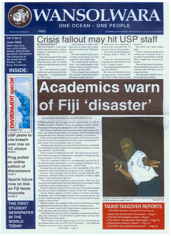 |
Figure 2: Front page of the controversial Wansolwara 'coup edition' which survived a university attempt to prevent its publication, June 2000. |
The University of the South Pacific is a regional university with 12-member countries with main campuses in Suva, Port Vila and Apia. The newspaper Wansolwara was founded in 1996 by journalism students and was initially not integrated into the journalism degree programme and has never actually been directly funded by the university. The students fund-raised to produce the paper. When this author arrived from the University of Papua New Guinea in 1998 to head the journalism studies programme at USP, he set about integrating the newspaper into a formal course assessment structure and established an advertising regime to recover printing and production costs. Wansolwara has arguably been the most successful economic model for a training newspaper in the South Pacific region because it has been able to self-fund publication for almost two decades and consolidate its publishing structure (Robie, 2008). Until recently, it was published on the model that this author originally established with a redesign and revamp in 1998 (Robie, 2004). It has won many awards, several of them gained during the tenure of the most recent Head of Journalism, Shailendra Singh, who developed the newspaper for the next seven years. During the attempted coup by George Speight in May 2000, the newspaper published a special edition and also maintained daily website reports on what was described as the “internet coup” (Figure 2) (Robie, 2004). Already having won a human rights prize in Fiji and a runner-up award in the annual Journalism Education Association (JEA) Ossie Awards for student journalism the previous year, Wansolwara journalists dominated the awards in 2000. Judge Mike van Niekerk, deputy editor of The Age Online, noted that the students:
rose to the challenge of providing high quality reports of a dramatic international event on their doorstep. [...] Taken as a body of work, it is very impressive. (Pearson, 2001: 19).
Pedagogy
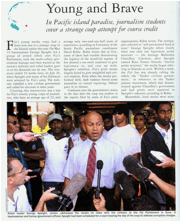 |
Figure 3: ‘Young and brave – Fiji’s student reporters cover coup,’ IPI Global Journalist, 3rd Quarter, 2000, pp. 26-28. |
Editors were drawn from the third year News Production course, subeditors were on the second-year Print and Online Journalism paper and reporters were on the first year Introductory Journalism and Media Law and Ethics papers. All reporters turned up at the newsroom to be briefed and were assigned to do news stories and pictures, or offered their own stories. Some editors were in charge for a complete semester, others worked in split semesters (This usually depended on whether students were on six-week internships with news organisations) (Robie & Singh, 2004).
The major highlight of this period – and one of the most extraordinary and stressful times that this author has ever experienced as an educator was the reporting by both the website and newspaper volunteer students for two months during an attempted coup in 2000 by businessman George Speight, who held the elected government hostage in Parliament for 56 days. This was a considerable potential risk for the students. However, many of them had some industry experience and life skills, including one student who was a police inspector.
The university had made the decision to officially close the Laucala campus in the Fiji capital of Suva and sent most of the resident students home to their countries. For a 48-hour period, Fiji operated under martial law; for two months a curfew was imposed by the military. Staff needed to weigh up the desire of the students to gain the “experience of a lifetime” in covering the coup and the possibility of one of the students being shot or otherwise injured in a violent clash and my personal responsibility as an academic (Figure 3). Most of the students were in fact no younger than the staff journalists on media organisations, and were actually arguably better trained/educated. In the end, the student volunteers were backed and they were vindicated by the international awards they won in December 2000. A mirror website was set up at the University of Technology, Sydney, when their own USP website was closed by university authorities.
Participant feedback
A decade later, this PBL learning experience was reflected on and a number of the students involved were interviewed about how their experience had impacted on their career (Robie, 2010). All of them found this PBL experience very positive and a boost to their careers, For example, the reflections of then Wansolwara editor Reggie Dutt (who described it as the “defining moment of my career in journalism” [R. Dutt, personal communication, 24 March 2011]) and online editor Christine Gounder concluded a decade later:
At the time, reporting on the May 2000 coup was an exciting challenge for me. At no point did I stop to think about not reporting, or continuing to go to university every day to work on Pacific Journalism Online [the web version of Wansolwara], while the semester was put on hold by the university. Only when the university closed down the website, did I think the situation through. Even then, I was against the university’s decision to shut us down and felt it was unfair to prevent us from learning “on-the-job” from this unique experience.
As it happened, a number of avenues opened up for PJO to be published on mirror sites, like the one created at ACIJ… [I] was happy that we had the mirror sites to publish our stories on. Would I do the same all over again? Without a moment’s hesitation. (R. Dutt, cited in Robie, 2010: 120)
I feel privileged to have been part of the student team that took the opportunity to put to use the skills learnt in the school newsroom into practice. It was both a nervous and exciting time and something we can be proud of for our lifetime. I still remember the day we received a threatening call asking us to shut down Pacific Journalism Online as we were one of the few telling the world what was happening in Fiji. That phone call made us aware of how important our job was and made us want to work even harder. (C. Gounder, cited in Robie, D., 2010: 120)
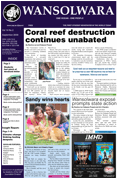 |
Figure 4: Front page of the first Wansolwara edition published by the Fiji Sun, September 2009. |
Development
Nine years later, on 20 September 2009, Wansolwara came off the presses of a Fiji daily newspaper for the first time in its 13-year history (Figures 4 & 5). The 16-page paper was read as a liftout in the press run of an estimated 10,000 copies of the Fiji Sun, now the dominant daily in Fiji because of its monopoly on state advertising since the 2006 coup. A further 2000 copies are printed for Wansolwara’s regional and international mailing list. This makes it easily the largest circulation of any student newspaper in the Pacific, Australia and New Zealand (Fiji Sun boosts Wansolwara’s readership, Pacific Scoop, 21 September 1999). Singh said at the time that the newspaper was pleased to accept an offer from the Fiji Sun publisher, Peter Lomas, to print and distribute Wansolwara at no charge as a commitment to Fiji journalism education and training. This was only the third time in the South Pacific that a student publication had been printed by a daily newspaper. In 1999, a sister student paper of Wansolwara—Spicol Daily—was printed as an insert daily for a week by the Fiji Daily Post with the support of then editor Jale Moala. In Papua New
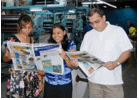 |
Figure 5: Head of Journalism Shailendra Singh and students check the first copies of Wansolwara printed on the Fiji Sun press, September 2009. |
Guinea, the University of PNG journalism student-run newspaper Uni Tavur was printed by the PNG Post-Courier from 1995 onwards until it ceased regular publication after 1998. No student publications in Australia or New Zealand are published by a mainstream daily newspaper in a comparable “piggy-back” manner.
Singh points to the importance of the student newspaper for the region because of its Pacific-wide focus: The USP is a regional university with 14 member countries and is the leading tertiary institution in the Pacific, one of the largest transnational organisations – a remarkable success story – yet related issues are “not covered adequately by the regional media” (S. Singh, personal communication, 27 May 2011). Wansolwara attempts to fill such gaps. “It gives USP student/staff a voice and the kind of coverage national/regional media is unable to do. USP is funded by regional governments to the tune of millions of dollars annually, so there are accountability issues that are taken up by Wansolwara when the need arises.”
Now in its 15th year of publication, notes Singh, Wansolwara has developed a “niche readership” with a focus on the environment and USP issues while covering the region and Fiji from its Suva base (Ibid.). As well as the annual JEA and human rights awards, the paper has won environmental awards, including a 2011 South Pacific Regional Environmental Programme (SPREP) commendation for its contribution to environmental journalism in the region. “Wansolwara does not face the commercial pressures of the mainstream newspapers so it is more open-minded and less afraid to try new things and experiment,” argued Singh (Ibid.)
 |
Figure 6: The new masthead logo for Wansolwara, May 2011. |
In May 2011, Wansolwara was relaunched with a redesigned logo and format to mark the planned revival of the online edition, which had not published since 2007, and to revamp the campus FM station Radio Pasifik (Figure 6). “The relaunch was deemed necessary as the website has been down for years and the newspaper is being redesigned. The website is also being designed to at least incorporate documentaries from Radio Pasifik and the television course,” said Irene Manueli, a former Fiji Times journalist now an assistant lecturer in charge of the news media outputs from the USP journalism programme (I. Manueli, personal communication, 27 May 2011). Her primary job is to look after the print and online versions of paper and work closely with students, providing one-on-one newsroom support. This is a major boost as this role has previously been carried out by lecturers on top of their classroom duties. Her pedagogical suggestions include:
Wansolwara needs to publish more regularly – at the very least once a month – so as to give students sufficient practice. It can only be possible through a system that ensures all students deliver their assigned stories. A standard of assessment also needs to be established to ensure quality and fairness (Ibid.).
Summary
Just as the mainstream Fiji news media has been subjected to tough censorship conditions imposed by the Fiji News Media Industry 2009 Decree, Wansolwara’s students and staff need to be careful about what they publish. This is a delicate and frustrating problem that compounds other changes facing the student newspaper for the future.
Wansolwara, like all other Fiji-based papers, has to comply with the media decree or face being shut down or [risk] its student journalists [being] prosecuted. As a student newspaper, there are no censors present in our newsroom but the paper has to self-censor. One great difficulty is that the paper is unable to mount any valid criticism of the Fiji government. This restriction is totally new and at times hard to stomach, even though in the past the newspaper has been criticised from within USP by some academics for being too political when it questioned regional and Fiji government [policies]. These academics were apparently concerned about angering governments which fund USP. Or they were political supporters of the government that was being criticised or scrutinised. (Singh, ibid.)
Case Study 2: PMC Online and Pacific Scoop
Context
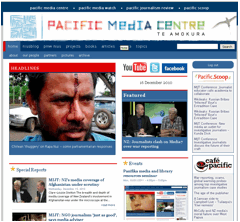 |
Figure 7: Pacific Media Centre Online frontpage. |
Pacific Media Centre Online was established in mid-2007 as the umbrella website for AUT University’s Pacific Centre in providing independent research tools, publications and resources for the region (Figure 7) http://www.pmc.aut.ac.nz. It also initially became the publication outlet for students on a relatively new postgraduate Asia-Pacific Journalism paper, established in 2007 as the first course of its kind at any New Zealand university. The PMC Online website was closely associated with the Pacific Journalism Review research journal’s website http://www.pjreview.info and the Pacific Media Watch monitoring service and database initially established on a DSpace server http://www.pacmediawatch.aut.ac.nz Both the PMC and New Zealand’s major independent news website, Scoop Media Ltd, were frustrated with what they perceived to be weak specialist news and analysis coverage of the South Pacific region. They moved to establish a website catering for this niche field, mainly through the efforts of Scoop co-editor Selwyn Manning and the PMC director, Associate Professor David Robie. In August 2009, a partnership between the PMC and the Scoop Media group resulted in the launching of Pacific Scoop as a joint collaborative publication at the AUT Māori Expo. This was a unique development between an industry media group and an academic institution. Recalled Scoop co-editor and general manager Alastair Thompson:
Pacific coverage is something that Scoop has focused on since we were founded in 1999 shortly before New Zealand hosted APEC in Auckland. We have always sought to service New Zealand news needs with an eye on the international – and in that regard the Pacific is the area that we as a nation are most concerned with and most engaged with. We also identified that the Pacific is an area which is poorly covered by New Zealand and international media and is therefore something we could make an impact in. In the four years from 2004-2008 Scoop had also covered the Pacific Forum closely (A. Thompson, personal communication, 23 May 2011).
Scoop is ranked third by the Neilsen Net/Ratings in their news category and was “finally recognised” in the Qantas Media Awards as a finalist for Best News Site in 2007 (Introducing Scoop.co.nz, 2011). According to Scoop’s main website, it “brings together the information that is creating the news as it is released to the media, and is therefore a hub of intelligence for the professionals (not just media) that shape what we read”. The website delivers the news of the day in a “no spin media environment” and also provides the “full context of what is ‘reported’” as news later in the day. Its audience has a “circle of influence far greater than the number of reported readers”, which averages more than 500,000 a month.
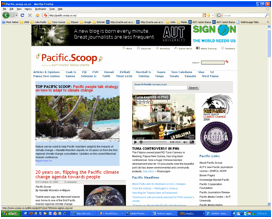 |
Figure 8: Pacific Scoop front page, September 2009. |
Scoop.co.nz presents all the information driving the news of the day in the form it is delivered to media creating a “no spin” media environment and one that provides the full context of what is “reported” as news later in the day. “Our audience is high-value, professionals with a social and environmental conscience, and also a discerning general readership seeking an alternative to other major news media,” noted the website.
According to Thompson, the opportunity to work with the PMC arose shortly after this author set up the centre. “We had previously worked with David in coverage of the Fiji coups and other Pacific news via his Pacific Media Watch service,” he said. “Around the same time, we had just established the hosting infrastructure which made launching and populating Pacific Scoop significantly easier” (Figure 8). The PMC’s connections to media organisations and contributors throughout the Pacific “are unparalleled” and so it seemed like a relationship which would “work well for both parties” (Thompson, ibid.). Thompson described the weaknesses of New Zealand media reportage of the region thus:
Generally coverage of the Pacific only occurs in New Zealand media in times of crisis and disaster. This is not ideal. Scoop’s stream of raw news (press releases and speeches), however, is [fairly] constant and can form a more comprehensive backdrop to the news coverage which is provided by PMC's correspondents and students when news of significance to them arises. (Ibid.)
Co-editor Selwyn Manning reflected after the launch of Pacific Scoop:
Once the idea was conceived, common ground between Scoop Media and the Pacific Media Centre was identified. We shared a vision on creating and sustaining a web-based media hub that would offer insightful items (both written text and multimedia reports) to an audience that is interested in, and active in, Pacific issues and affairs both here in Aotearoa/New Zealand and in the wider Pacific region” (S. Manning, personal communication, 10 October 2009).
Pedagogy
Pacific Scoop described itself on its own website as a new regional “hub” portal partnership venture: “The idea is to produce a distinct blend of news, current affairs and analysis – a fresh and independent ‘voice’ of the Pacific … We are keen to tell the hidden stories and address justice for the marginalised.” Education, culture, creativity, environment, health, human rights, media, social justice, resource development, regional security and technology are some of the topics high on the reportage and learning list for student journalists. “Pacific Scoop is a good example of developing synergies between academia and industry,” noted Manning (Ibid.) It is an example of a symbiotic relationship between Scoop Media and the PMC. The centre brings a wealth of experience on Pacific affairs, and alongside this experience comes the “respect of significant academics, journalists, students, decision-makers from throughout the Pacific”. These contacts, and the information they submit to Pacific Scoop, is what sets it aside from other online offerings.
Students at AUT University on the postgraduate Asia-Pacific Journalism paper produce the bulk of the original copy and images. They are required to produce a portfolio of three in-depth news feature articles on a Pacific issue of up to 1200 words and a minimum of five sources. Supplementing the daily file from students from AUT, Divine Word University in Papua New Guinea, USP and the National University of Samoa are articles by leading Pacific academic staff, such as economics professor Wadan Narsey, development studies professor Crosbie Walsh, and governance Associate Professor Scott MacWilliam at the Crawford School of the Australian National University, and regional journalists and civil society advocates and analysts. Complimenting the PMC’s initiative, Professor Walsh, who founded the development studies programme at the University of the South Pacific, is himself a prominent Fiji blog publisher (crosbiew.blogspot.com) and authored a definitive paper on Fiji political and media blogs (Walsh, 2010), noted:
There are television and radio channels devoted to the Pacific but they are aimed primarily at a Pacific Islander audience. Pacific Scoop appeals to a wider audience, it can (and does) publish controversial material and, other than the blogs, readers interested in Pacific Islands affairs have nowhere else to go… Its neutrality and political balance gives it entry to places where the more polemical blogs rarely trespass. I think its greatest weakness is its vulnerability: it relies too heavily on the work of one man, and it operates on limited finances. (C. Walsh, personal communication, 26 May 2011).
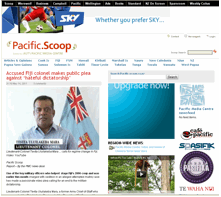 |
Figure 9: Pacific Scoop coverage of the Ratu Mara's YouTube allegations against the Fiji regime from Tonga. A breaking news story, 14 May 2011. |
For Scoop Media’s part, it provides the technical support, absorbs data costs, shares its brand with the PMC, and pushes its audience to Pacific Scoop. “While we share similar editorial goals, Scoop does not interfere with the PMC’s editorial line, but rather encourages methods of assisting traffic growth and Pacific Scoop’s identity,” observed Manning (Ibid.). While editing Pacific Scoop during 2010, Manning arranged special coverage of the Pacific Islands Forum in Port Vila, Vanuatu, by two Pacific Islands student journalists at AUT funded by a grant from the Ministry of Foreign Affairs and Trade (MFAT). (One of the students became media adviser for the Tongan government the following year).
Development
Within one month of its launch, Pacific Scoop attracted more individuals than any other sub-site in the Scoop network. By October 2009, Pacific Scoop had attracted more than 30,000 individuals and appeared briefly to be well on track to achieving a goal of 40,000 individuals for the month of March 2010. That traffic would have placed it well ahead of Radio New Zealand International’s website, and, according to Manning “alongside well established brands such as Public Address (Russell Brown’s blog), Radio New Zealand, and the National Business Review website”. However, this initial optimism was fuelled by a huge spike in audience at the time of a Samoan tsunami in September 2009 when more than 189 people died. Competitive reporting from both Pacific Scoop’s New Zealand student reporters and correspondents on the ground in Samoa provided comprehensive and independent coverage. Since then, the website audience has fluctuated depending on the stories and the student and staff resources available at the time. One student contributing editor, Alex Perrottet, travelled to Samoa in September 2010, and wrote a series of four articles with an investigative edge focusing on the post-tsunami reconstruction and the record of the aid agencies. His perceptive articles won him a highly commended award in the “best online story” category of the annual Journalism Education Association of Australia Awards (Samoan tsunami recovery series wins, PMC Online, 8 March 2011).
Following the Tōhoku earthquake and tsunami in Japan (with at least 15,234 deaths) and a subsequent Pacific-wide warning with a tidal wave wreaking havoc on Hawai’i Island, with both Pacific Scoop and PMC Online’s extensive coverage of this and the nuclear power plant environmental story, the PS website audience peaked again. This time the audience was more than 23,000 and after a plateau, it spiked again with exclusive reports on the defection of a high-profile and chiefly military colonel from the military-backed regime in Fiji. Ratu Tevita Mara fled to the neighbouring kingdom of Tonga on 13 May where he began waging a “cyberspace war” on the junta through YouTube and the media
(Figures 9, 10). Pacific Scoop students covered this controversial story extensively and generally better than mainstream media. In September 2011, 10 students from four countries – Australia, New Zealand, Germany and Nigeria were accredited to report on the South Pacific Forum and the visit of the United Nations Secretary-General, Ban Ki-moon, to Auckland. Their 167 in-depth stories covered climate change, domestic violence and human rights, urban and rural development and West Papuan self-determination as well as the Forum issues. Many articles were widely republished by Forum country newspapers and the Pacific Scoop collection has been archived.
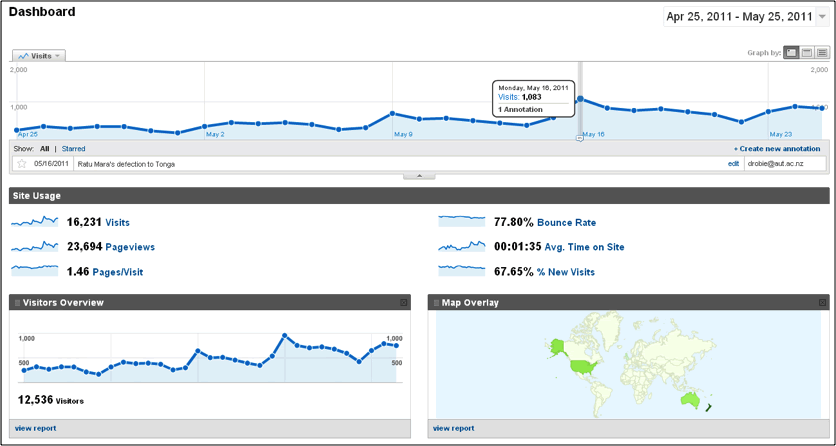 |
Figure 10: A "spike" on Pacific Scoop with an exclusive report or the fugitive colonel Ratu Tevita Mara making YouTube accusations against the Fiji dictator Commodore Voreqe Bainimarama. http://pacific.scoop.co.nz/2011/05/accused-fiji-colonel-makes-public-plea-against-hateful-dictatorship/ Source: Google Analytics, 27 May 2011. |
Pacific Media Centre Online, relaunched in December 2010 during the international Media, Investigative Journalism and Technology (MIJT) conference, increased its audience fivefold in the months that followed, also helped dramatically by a post-tsunami spike. It has rapidly established itself as an authoritative niche website on Asia-Pacific media issues and also an important repository and index for media research as well as its more general reportage outlets for postgraduate students and staff.
Participant feedback
A cornerstone for both these websites is the postgraduate paper Asia-Pacific Journalism. Students undertaking this course need to file a portfolio of in-depth news features on Asia-Pacific affairs, drawing on a minimum of five sources and delivered as a text-based package with pictures, or as multimedia stories. Along with this paper, the PMC has also developed an international internship project in China, Indonesia and the Philippines over the past six years. Some 13 students have been involved in these internships at the China Daily, Jakarta Globe and Post and Philippine Star, and many have returned to Asian countries to get paid media jobs at international news agencies or radio stations (Figure 11). One graduate returned to Beijing from Singapore, where he now works for a media company, to head the China Daily.com’s English-language multimedia team covering the 2008 Beijing Olympic Games. The internships are tagged to an optional 30 point postgraduate project credit for the Masters programme. Since the APJ elective has been taught, there has been a high level of enthusiasm for the paper (SELs and SEPs, 2007, 2008, 2009, 2010).
 |
Figure 11: Kim Bowden, currently the PMC international internship graduate at the China Daily.com |
The guest speakers. We had such a great range of inspirational Asia-Pacific journalists come to speak to us. I had no idea this paper would include such interesting people – what a great surprise.
Hearing a vast range of perspectives and voices from across the Asia-Pacific region, including nations I have never known about.
Waking up to what other issues there are in the Pacific. I was living in a 2D world, but after this class 3D reality has hit me. Like the situation in West Papua and the Philippines.
This is the best way to teach. More papers should follow this method and structure. It was always interesting – you didn’t want to miss a class. (SEP, 2010)
Summary
New Zealand, Australia and the US are the biggest sources of the Pacific Scoop audience, followed by Fiji, United Kingdom, Canada and Indonesia in that order. Visitors are recorded from most countries in the world and there is a fairly complete set of visits from the Pacific. The vision of a Pacific media-driven news website powered by Scoop which is making an impact in the coverage of Pacific issues is being achieved (A. Thompson, personal communication, 23 May 2011). However, resourcing is always an issue. Ideally, the site needs sufficient ongoing editorial management support to enable Scoop and the Pacific Media Centre to focus on the main goal – the pursuit of excellence in news coverage from the region. Increasing the level of readership in the islands would also be desirable. Scoop would also like to set up an email style service concentrating on Pacific news which could be used to feed back the news that we publish to both its producers and civil institutions in the region. While normally this would be a commercial service – in the case of the Pacific, it is unlikely to be possible.
Conclusion
The central paradox of the news media as a political institution and a cornerstone of democracy that measures its success by the criteria of profit and audience numbers is “highlighted by the five elements central to the rhetorical and philosophical justification of the Fourth Estate” (Schultz, 2009). Schultz identified the elements as political purpose and independence; commercial priorities; the importance of public opinion; the diversity of information and viewpoints presented; and the degree of accountability. Journalism education today is about engaging these elements and producing well-rounded, well-educated journalists who have sound critical thinking abilities and a commitment to the media being part of the broader society’s solutions, not adding to its problems. Quality and independent campus-based media play a critical role in developing the full potential of student journalists. Such media is founded on a robust methodology of experiential and problem-based learning with reflexive workshops. Journalists with a quality all-round tertiary education with a strong exposure to disciplines such as business, economics, geography, government, history/politics, human rights, language and culture, and the environment are a sound investment in a nation’s cultural capital (Robie, 2004: 248). An independent student media contributes to a new generation of journalists who have a deeper self-understanding and a stronger sense of the Fourth Estate for the benefit of all society.
References
Berney, C. J., and Robie, D. (2007). Don’t publish and be damned: An advocacy media case study. Global Media Journal, 2(1). Retrieved on 15 May 2011, from http://www.hca.uws.edu.au/gmjau/iss1_2008/bernie_robie.html
Bhim, M. (2010). A case for Fiji’s grassroots citizenry and media to be better informed, engaged for democracy. Pacific Journalism Review, 16(2), pp. 127-146.
Boyd-Bell, S. (2007). Experiential learning in journalism education – A New Zealand case study. Unpublished Masters thesis. Auckland: School of Education, Auckland University of Technology.
Dixit, K. (2010). Dateline earth: Journalism as if the planet mattered. Bangkok: IPS Asia Pacific Foundation.
Dutt, R. J. (2010). The Fiji media decree: A push towards collaborative journalism. Pacific Journalism Review, 16(2), pp. 81-98.
Hanney, R. (2005). Competence or capability: Work-based learning and problem-based learning. Journal of Media Practice, 6(2), pp. 105-112.
Hartnett, S. J. (2010). Communication, social justice and joyful commitment. Western Journal of Communication, 74(1), pp. 68-93.
Jayarajan, N. (2010, June 30). Fiji promulgates media law further restricting press freedom, International Press Institute. Retrieved on 27 May 2011, from www.freemedia.at/singleview/5019/
Fiji Sun boosts Wansolwara’s readership with hot press deal. (1999, September 21). Pacific Scoop. Retrieved on 26 May 2011, from http://pacific.scoop.co.nz/2009/09/fiji-sun-boosts-wansolwaras-readership-with-hot-press-deal/
Introducing Scoop.co.nz: Unique, independent and necessary in NZ (2011). Retrieved on 27 May 2011, from http://www.scoop.co.nz/about/about.html
McChesney, R. W., and Pickard, V. (2011). Will the last reporter please turn out the lights: The collapse of journalism and what can be done to fix it. New York, London: The New Press.
Meadows, M. (1997). Taking a problem-based learning approach to journalism education. AsiaPacific MediaEducator, No. 3, December, pp. 89–107.
Merrill, J. C. (1996). Existential journalism. Ames: Iowa State University Press.
Morgan, A. N., Pifer, A. I. , and Woods, K. (2006). The authentic voice: The best reporting on race and ethnicity. New York: Columbia University Press.
Pearson, M. (2001). Ossies recognise promising talent of the future. PANPA Bulletin, February, 19.
Pearson, M. (2000). Reflective practice in action: Preparing Samoan journalists to cover court cases. AsiaPacific MediaEducator, No. 8, January-June: pp. 4–33.
Robie, D. and Singh, S. (2004). From campus to newsroom in the South Pacific: Governance and the quest for a professional journalism ethos. Fijian Studies: A Journal of Contemporary Fiji, 2(2), pp. 245–268.
Robie, D. (2010). Pacific freedom of the press: Case studies in independent campus-based media models. Pacific Journalism Review, 16(2), pp. 99-126.
Robie, D. (2004). Mekim Nius: South Pacific media, politics and education. Suva: University of the South Pacific Book Centre.
Robie, D. (2008a). An independent student press: Three case studies from Fiji, Papua New Guinea and Aotearoa/New Zealand. In Papoutsaki, E., and Harris. S. (eds.), South Pacific Island Communications: Regional perspectives, local issues (pp. 235-253). Singapore: Asian Media Information and Communication Centre (AMIC).
Robie, D. (2008b). Media and development in the Pacific: Reporting the why, how and what now. In Singh, S., and Prasad, B. (eds.), Media and development: Issues and challenges in the Pacific Islands (pp. 11-26). Suva: Institute of Applied Studies.
Samoan tsunami recovery series wins Perrottet student media honour. (2011, March 8). Pacific Media Centre Online. Retrieved on 27 May 2011, from http://www.pmc.aut.ac.nz/pmc-blog/2011-03-08/samoan-tsunami-recovery-series-wins-perrottet-student-media-honour
Savin-Baden, M. (2003). Facilitating problem-based learning. Maidenhead: Open University Press.
Schultz, J. (1998). Reviving the fourth estate: Democracy, accountability and the media. Melbourne: Cambridge University Press.
Sheridan Burns, L., and Hazell, T. (1999). Problem-based learning, youth suicide and media’s responsability. AsiaPacific Media Educator, No. 6: pp. 56–71.
Singh, S. (2010). Life under Decree No. 29 of 2010: The Fiji Media Development Decree. Pacific Journalism Review, 16(2), pp. 147-162.
Walsh, C. (2010). Political blogs on Fiji: A ‘cybernet democracy’ case study. Pacific Journalism Review, 16(1), pp. 154-177.
About the author
Dr David Robie is Professor of Journalism and Director of the Pacific Media Centre at Auckland University of Technology, Aotearoa/New Zealand. He is a former head of journalism at both the University of Papua New Guinea and University of the South Pacific (Fiji) for almost a decade. He is also the author of Mekim Nius: South Pacific politics, media and education.
